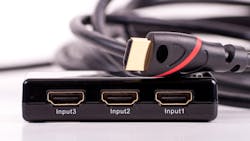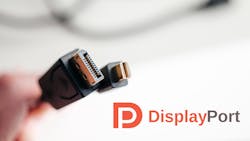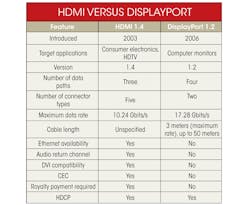Download this article in .PDF format This file type includes high resolution graphics and schematics when applicable.Updated 10/21/2022
HDMI (High-Definition Multimedia Interface) and DisplayPort technologies are modern serial interfaces designed to pipe audio and video to a compatible display. These standards replace the aging VGA (Video Graphics Array), DVI (Digital Video Interface) and FPD-Link standards for increased data bandwidth, resolutions and refresh rates to drive todays pixel-dense TVs and monitors. HDMI 2.1 and DisplayPort 2.0 are the latest revisions and provide new features such as support for 10K panels (@ 120 Hz), dynamic HDR, AR/VR support, up to 77.37 Gbit/s data rates and more.
Background
Video monitors for personal computers are analog products. They take their input from video controllers that use digital-to-analog converters (DACs) to convert the digital video display content into analog signals. There are analog interfaces like VGA and other variations depending on display resolution. Now, a digital video interface called DisplayPort is rapidly becoming the primary video standard for PCs, laptops, and other computers.
In addition, all video and audio used to be analog. But with the advent of CDs and DVDs, video became digital. In 2009, broadcast TV went fully digital. While analog interfaces like composite video, S-video, and RGB were used to transport video from one device to another, an all-digital interface was needed. The digital video interface (DVI) from Intel met some of that need, but today, HDMI has become the de facto standard for consumer electronics.
HDMI
HDMI is a standard from the HDMI Forum (Fig. 1). This non-profit organization develops and maintains the standard, manages its testing and certification for interoperability, and promotes it. More than 80 member companies support the Forum. The standard became available in 2003 and has been continuously updated. The current version is 2.1. It complies with the EIA/CEA-861 standards that define the video formats and methods of transmission for both compressed and uncompressed video and audio.
The consumer electronics industry has almost universally adopted HDMI as the “the” video transmission standard. It appears in HDTV sets, DVD/Blu-ray players, cable and satellite set-top boxes, AV receivers, digital games, digital cameras, video projectors, and some video monitors. It is even available on some tablets and smart phones.
Technically, the standard supports three differential serial data channels that carry the uncompressed video and audio. The protocol is called transition minimized differential signaling (TMDS), developed by Silicon Image. An 8B/10B coding scheme converts bytes into 10-bit codes for error detection and correction. Video is transferred as 24-bit pixels in synchronization with a separate clock channel. Ten bits are transferred per pixel clock period. The standard supports up to 48 bits of pixel data. Pixel clock rates can be any value within the 25-MHz to 340-MHz range. This allows 720p and 1080p resolution video with a 60-Hz refresh rate to be accommodated. The overall maximum possible composite data rate is 10.46 Gbits/s.
As for audio, HDMI uses linear pulse code modulation (LPCM). Support is provided for most popular digital audio formats like Dolby Digital, DVD and super CD audio, and DTS HD audio. The audio capability supports up to eight channels. HDMI also includes the audio return channel (ARC), which carries the audio from your TV set to an AV receiver without a separate audio connection as is common in some systems.
HDMI also incorporates High-bandwidth Digital Copy Protection (HDCP) to encrypt copyrighted video and audio material. It prevents protected material from being played or copied during transmission over the interface.
A separate display data channel (DDC) link provides a two-way communications capability between the transmitting source and the receiver. It is based on the popular I2C interface. DDC is used to notify the transmitter about the receiver configuration and features. Another separate consumer electronics control (CEC) channel provides control of multiple devices from a single source. Up to 15 devices are supported, so a single remote control can handle all HDMI-connected products.
These mulitwire bundles include four shielded twisted-pair lines (100-Ω impedance) for the data and clock plus individual data lines for the DDC and CEC connections as well as ground and power lines. A maximum cable length has not been specified, and a wide range of lengths is available. High-data-rate signals degrade quickly over length, so cables should be kept short. Cables as long as 50 feet are available, but considerable degradation occurs. Longer distances can be achieved by using repeaters or active cables that include signal regeneration circuitry. Fiber-optic cables can be used for distances of several hundred feet if needed.
There are four defined connectors for different applications. The most familiar is the A type with 19 pins that is used on most consumer electronic products. The B type connector uses 29 pins and doubles the data connections to six channels to provide a higher pixel rate to carry higher-definition formats. The type C connector is a mini version of the type A with the same 19 pins. It is used on portable devices like laptops and tablets. A micro type D connector is also available for even smaller devices. It too has 19 pins, but the pin-out is different from the other connectors. A type E connector targets automotive applications and includes a locking pin to prevent accidental disconnects due to vibration. A variety of adapters is available to convert from one connector type to another.
An interesting feature of the latest version of HDMI is the HDMI Ethernet Channel (HEC). By using two pins in the standard connector plus a special cable, a single 100-Mbit/s Ethernet channel is implemented. HEC is used primarily for audio control.
A major factor in designing HDMI into your product is the cost of adopting the standard. Your company must join the HDMI Forum with dues of $15,000 per year plus pay a royalty in the range of 3 to 15 cents per product sold. Version 2.0, expected in the near future, increases the clock rate to 600 MHz and provides support for 4K resolution HD video and 3D as well as faster refresh rates and newer audio standards.
DisplayPort
DisplayPort (DP) is a standard of the Video Electronics Standards Association (VESA), which develops, certifies, and promotes it (Fig. 2). More than 200 member companies support it. DP defines a standard for connecting PCs, laptops, and other computers to video monitors. It is also available on video graphics cards, docking stations, projectors, and other computer peripherals. It is mainly designed to replace VGA and DVI ports. DP can be used for consumer electronics but is not common. As a result, it does not compete directly with HDMI. It is an open standard that does not require a royalty payment. Introduced in 2006, the standard is now up to version 2.0.
DP uses one, two, or four differential serial data paths to carry the video and audio. The data is self-clocking at a bit rate up to 77.37 Gbits/s per path using clock rates or 162, 270, or 540 MHz. The data is transmitted in packets with an 8B/10B coding scheme. Maximum possible net data throughput is 17.28 Gbits/s with encoding using all four paths. Most major video formats are supported including 720p and 1080p, 24 bits per pixel, at 60-Hz refresh and up to 3840 by 2160, 30 bits per pixel, at a 60-Hz refresh rate.
The LPCM-formatted (linear pulse-code modulation) digital audio capability supports up to eight channels of audio with a 16- or 24-bit, 32- to 192-kHz sampling rate. Compressed audio formats are encapsulated. DP also can use multiple monitors. As many as four monitors with a 1920-by-1200 resolution may be daisy chained. With two connected monitors, the resolution may be up to 2560 by 1600.
A dual-mode feature called DP++ can carry single-channel HDMI or DVI by using a special adapter. This feature is found on some monitors and graphics cards. The DisplayPort Content Protection (DPCP) encryption scheme protects copyrighted material from being copied or transmitted. DP can also implement HDCP if it is licensed separately by Intel.
Conclusion
Both HDMI and DisplayPort technologies have improved dramatically over the last decade, and both will continue to evolve as the latest technologies come to fruition. The standards will continue to drive multi-panel displays at higher resolutions beyond 10K at increased bandwidths and frequencies. That said, HDMI and DisplayPort will only be able to handle so much bandwidth before a new standard is needed, and AI and domain specific processors (DSPs) will usher in wireless connectivity that will make those technologies obsolete. The idea is to place neural processors embedded in SoCs (System on a Chip) to run super-resolution algorithms to upscale today’s lower-resolutions (2, 4, 8 and 10K). It will be interesting to see how far developers can push HDMI and DisplayPort beforehand.
Originally published August 12, 2013.
References




